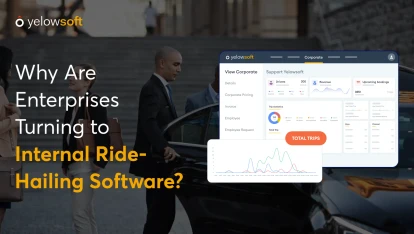The taxi and ride-hailing industry may look the same from a distance: cars, drivers, bookings, and rides. But once you zoom in, every region tells a completely different story.
In the UK, passengers expect punctual airport pickups with live flight tracking. In the U.S., operators focus more on driver performance, compliance, and safety. Meanwhile, Asia runs on high-volume automation, and the Middle East revolves around luxury experiences.
That’s where SaaS-based taxi solutions come into play. They give taxi operators the flexibility to tailor their systems based on market demands.
But here’s what many miss: the same SaaS platform can’t work the same way everywhere. The features that win passengers in London may not even make sense in Lagos.
This blog explores how regional market dynamics shape the way mobility businesses use technology and what kind of taxi dispatch or ride hailing solution makes sense for each region.
Because in mobility, understanding your market is everything.
Let’s begin the blog with the global shift towards SaaS.
The Global Shift Toward SaaS in Taxi Operations
The taxi industry has finally caught the SaaS wave, and for good reason.
A SaaS based taxi solution offers flexibility, scalability, and reduced upfront costs. This means you don’t buy bulky software or spend months on setup. You just subscribe, customize, and start running almost instantly.
Unlike traditional on-premise systems, SaaS platforms allow taxi operators to roll out updates, integrate new tools, and expand their fleets globally, all from one dashboard. It’s like having a full IT department in your browser.
Still, while the SaaS model is universal, how it’s used and valued differs by region. What’s “must-have” in one country might be “fine but what else?” in another.
So, in the next section, let's understand the regional dynamics:
Understanding Regional Mobility Ecosystems
Before diving into details, let’s first understand the basics of regional mobility.
The global mobility market can roughly be divided into five major ecosystems:
| Region | Reason |
|---|---|
| North America (U.S. & Canada) | Tech-heavy, safety-driven, compliance-focused. |
| Europe (UK & Western Europe) | Efficiency-led, regulated, and service-oriented. |
| Middle East | Luxury-driven with localization and data security as top priorities |
| Asia-Pacific | High-volume, price-sensitive, and automation-centric. |
| Africa & Latin America: | Reliability-first with lightweight tech and local integrations. |
Each region’s priorities shape what its ideal taxi booking solution looks like.
Let’s explore them one by one.
North America: Data, Drivers, and Experience
In the U.S., customer trust and driver accountability define the market. And taxi businesses focus on transparency, compliance, and safety more than anything else.
Operators here want driver management tools that go beyond tracking.
They want:
- Behavior monitoring
- Performance analytics, and
- Feedback-based scoring.
Passengers want to know they’re in safe hands, and businesses want proof.
So, a successful SaaS-based taxi solution in North America must:
- Track driver activity and trip performance in real time.
- Integrate insurance, background verification, and compliance systems.
- Offer data dashboards for decision-making, and
- Support multi-city scalability for expanding fleets.
Limo operators and corporate fleets in cities like New York and Chicago also demand premium control features like driver ratings, automated invoicing, and multi-account management.
In short, for this region, the winning mix is data, driver control, and digital experience.
United Kingdom & Europe: Efficiency and Connectivity
If there’s one word that defines the UK taxi and limo market, it’s efficiency.
Here, the competition is fierce. Operators juggle corporate transfers, airport rides, and pre-scheduled bookings every hour.
That’s why the ideal taxi dispatch solution here focuses on real-time fleet visibility, auto-dispatch, and integration with flight tracking systems.
A few must-have features for the UK and Europe include:
- Flight tracking for seamless airport pickups.
- Corporate invoicing and account management.
- Multi-channel booking systems: web apps, kiosks, and WhatsApp bookings.
- Dynamic pricing for rush hours or special events.
With growing environmental regulations, there’s also a rising demand for eco-routing and EV-friendly integrations.
Here, operators don’t just want a taxi booking solution; they want an ecosystem that helps them stay compliant and sustainable.
In these regions, time is money. And so automation isn’t optional but essential.
Middle East: Luxury, Scale, and Localization
In the Middle East, transportation isn’t just about moving from point A to B. It’s about experience.
From Dubai’s luxury limo services to Riyadh’s high-end corporate transfers, the expectations are high. And customers demand personalization, multilingual support, and premium comfort.
So, what works here is: A ride-hailing solution that’s visually elegant, easy to localize, and secure.
Plus, operators in this region prefer platforms that:
- Offer multi-language interfaces (Arabic, English, French).
- Support custom pricing models for VIP and chauffeur services.
- Provide real-time chauffeur tracking and communication tools.
- Comply with strict data protection and hosting regulations.
It’s also a region where white-label taxi apps make a strong impression. Operators prefer to carry their own brand identity rather than rely on aggregator apps.
In short, in the Middle East, it’s all about luxury wrapped in localization.
Asia-Pacific: Scalability and Automation
Nowhere is the mobility market as dynamic as in the Asia-Pacific. From India and Indonesia to Thailand and the Philippines, startups and local fleets are scaling fast.
Here, the focus is on high-volume ride-hailing operations where automation drives survival. The region thrives on affordability and speed.
A solid SaaS taxi solution in this market must handle:
- Auto-dispatch and instant ride allocation to reduce waiting time.
- Heat maps and predictive analytics to forecast demand peaks.
- Driver subscription models for flexible partnerships.
- Wallet integrations (Paytm, GCash, GrabPay) for faster payments.
- Multi-city configuration to scale operations fast.
Moreover, the operators here prefer modular platforms to start small and add features as they grow. The more automated and scalable the system, the stronger its competitive edge.
As they say: “In Asia, your fleet isn’t growing unless your dispatch is.”
Africa & Latin America: Accessibility and Reliability
These regions are building strong foundations for digital mobility.
Markets like Nigeria, Kenya, Mexico, and Peru are full of potential, but they have unique challenges like connectivity gaps, low smartphone penetration, and diverse payment methods.
So, the perfect taxi booking solution here focuses on reliability, simplicity, and local adaptability.
Key feature demands include:
- Offline booking support for low-internet zones.
- Payment gateway flexibility (Pesapal, Paystack, Flutterwave, Niubiz).
- Lightweight driver and passenger apps.
- Fraud detection and driver verification.
Additionally, these markets value consistency over complexity. So, they want tech that simply works, even when networks don’t.
A white-label taxi app here gives local entrepreneurs independence from aggregator giants like Uber or Bolt, thereby letting them build sustainable local mobility brands.
Bottom line: For Africa and LATAM, reliability truly trumps everything else.
How Regional Insights Shape Modern SaaS Taxi Platforms
Modern SaaS-based taxi solutions succeed when they understand the local pulse. The regional differences that we’ve discussed above directly influence how companies design, deploy, and refine their mobility tech.
For instance:
- In the UK, integrating flight tracking and automation tools drives retention.
- In the U.S., advanced driver analytics and compliance modules build trust.
- In Africa, offline functionality and local payments make or break the experience.
And global taxi operators increasingly look for platforms that offer this kind of flexibility, which is adaptable enough to fit local realities while maintaining a consistent user experience.
Conclusion
The future of mobility is SaaS-driven, but the success of any taxi dispatch solution depends on how well it fits the local market. Because the best platforms don’t just automate rides, they adapt to people, culture, and geography.
And a small tweak like enabling multi-language support or adding heatmaps for peak demand can redefine efficiency. So, businesses that embrace regional customization gain an undeniable edge because success in mobility is never about technology alone; it’s about relevance.
That’s why Yelowsoft builds its SaaS taxi solutions to reflect local needs while delivering global excellence. From predictive dispatching to multilingual interfaces and seamless integrations, Yelowsoft empowers taxi operators worldwide to run smarter, scale faster, and serve better.
Whether you’re a fleet owner in London, a ride-hailing startup in Bangkok, or a limo operator in Dubai, your business deserves software that understands your market as deeply as you do.
Ready to explore a SaaS taxi solution tailored for your region?
FAQs
A SaaS-based taxi solution runs on the cloud. You don’t install or maintain it manually. Plus, it updates automatically, scales easily, and reduces your operational costs significantly.
Yelowsoft taxi dispatch solution customizes modules based on local market needs, like flight tracking in the UK, multi-language support in the Middle East, or offline booking in Africa.
Because of high booking volumes, automation through auto dispatch and predictive analytics ensures faster rides, better utilization, and increased revenue.
Absolutely. White-label taxi apps let local operators launch their own branded apps while offering independence, flexibility, and market identity without building from scratch.
With Yelowsoft, you get one platform optimized for local success, supported by global expertise. Plus, Yelowsoft evolves with your region’s needs, from compliance to customer experience, to help you offer the best taxi services in your region.




